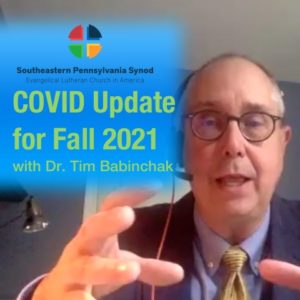October 1, 2021 in Communications, Public Health
Answers to Your Questions From Dr. Babinchak

Dr. Tim Babinchak, an infectious disease specialist and member of St. John’s Lutheran Church, Phoenixville, has been offering guidance for responding to COVID to SEPA Synod this year. Here he answers some current questions from SEPA leaders. If you have a question for Dr. Babinchak, please send it to Pastor Bob Fisher at .
What is our experience locally with “breakthrough” infections, and with pediatric illnesses and hospitalizations?
Our local experience is mirroring the rest of the country that has similar vaccination rates. I don’t like to call them “breakthrough” infections because the vaccines were never developed to “prevent infection”. Rather, the goal is to reduce the severity of illness and the need for hospitalization (and subsequently mortality). And this they have done remarkably well. No vaccine is perfect, and the efficacy of the current vaccines remains >90% on average, including the variants. That still means that even 10% of individuals vaccinated will still experience infection. These infections are more likely asymptomatic or mild, and of a shorter duration. The infections requiring hospitalization are still >90% in the unvaccinated.
Do we know much about both the seriousness of illness in young children and/or the length of hospitalization they are requiring?
Children still tend to experience mild infection with fewer than 5% requiring hospitalization. However, that can still be a high number given that many of these children are still not eligible for vaccination. And, yes, some cases are quite severe.
What do you see happening with the virus locally over the coming weeks?
The trends in our area are declining cases and hospitalizations, but that varies given the location. Once again, it is a direct reflection of the rate of unvaccinated individuals in the communities. Most of our immediately surrounding counties are in the low to moderate transmission categories. But where there are high pockets of unvaccinated individuals, transmission continues to be brisk.
Media has been very quiet about variants other than Delta. What is happening in terms of variants?
Variants will continue to arise, however, so far none have been identified that are either more transmissible or more likely to cause severe disease.
As cases remain high, do we need to think about a “new careful” — double-masking to protect kids? Cutting back on singing, or singing masked?
My recommendations here remain the same. All our social distancing, masking and hand washing should continue to the extent reasonably possible (double masking, reducing singing or singing masked may be helpful, but these are not contributing significantly to the continued transmission). Again, the limited amount of time spent in the confined areas, if socially distanced and with good ventilation has been shown to be most effective. Importantly, don’t attend if you don’t feel well.
What can we do in a church building that cannot bring in outside air through its systems — is opening windows enough? Will we need to keep that up even as it gets colder?
Increasing air circulation has been shown to be quite effective. Opening windows if the HVAC can’t be increased can help to increase circulation. Yes, even when it gets colder.
Many clergy were vaccinated early. How concerned should we be with waning immunity as winter and flu season approach?
Fortunately, for the generally healthy, the initial vaccine regimens remain very effective, even without “boosters”. As above, this is measured by reduced severity and lower hospitalizations. This is the evidence that prompted the decision to provide “boosters” only to those most vulnerable. In these cases, it is the other underlying illnesses and conditions that make any infection more serious. Thus, if an individual does have a qualifying condition, then boosting has been shown to be beneficial.

